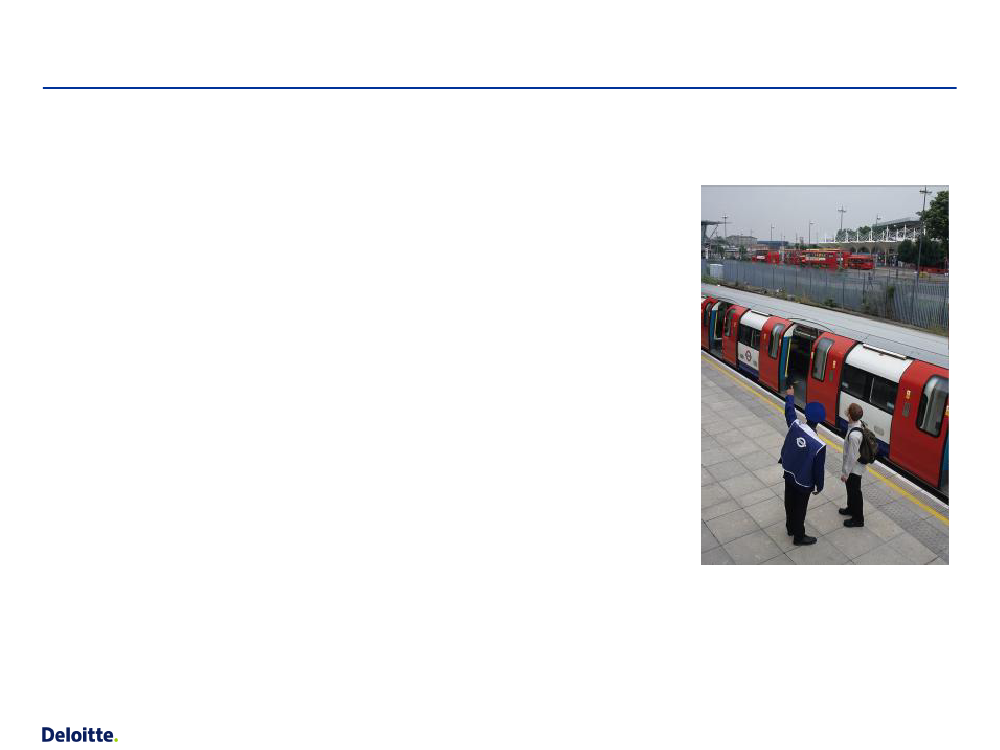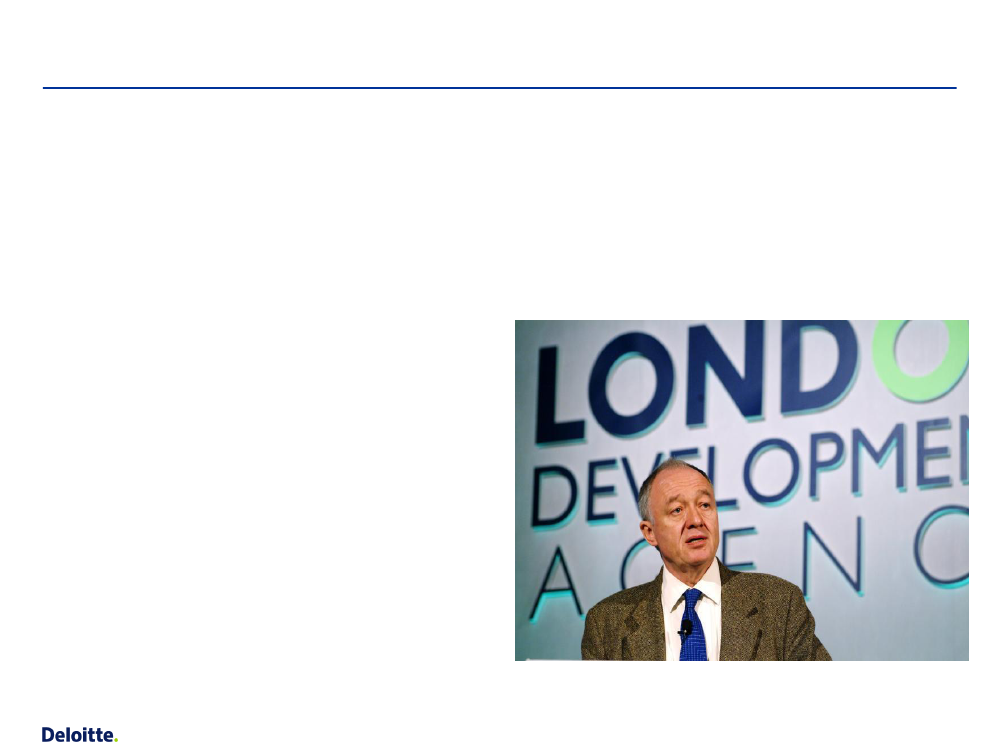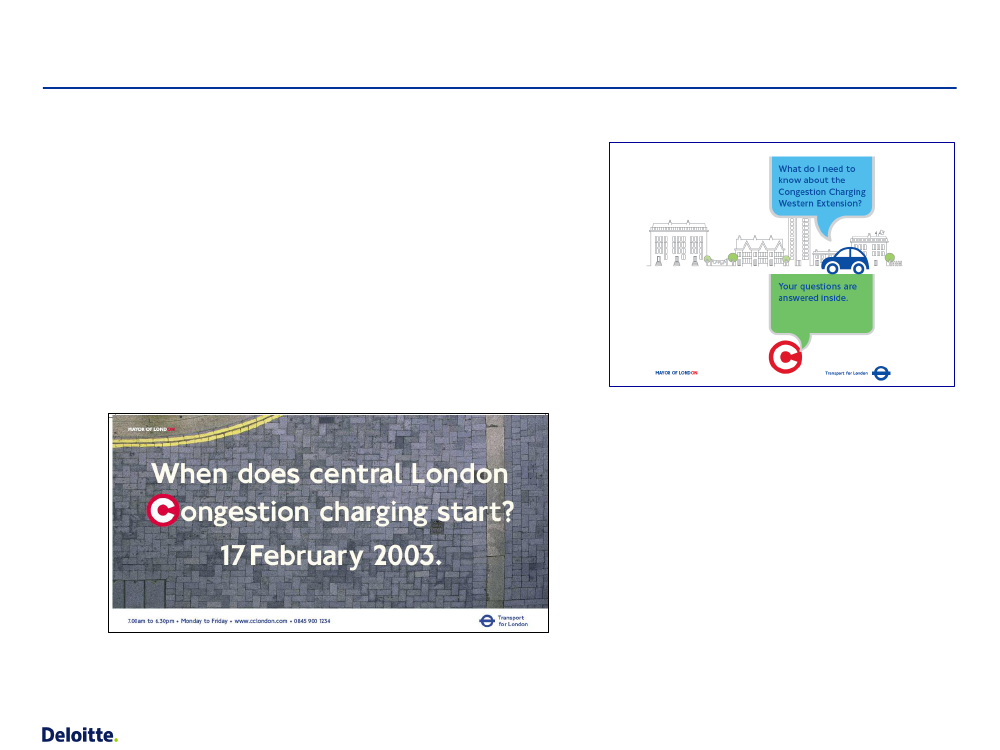Skatteudvalget 2011-12
SAU Alm.del Bilag 39
Offentligt
London congestion chargingConference presentationIan Simpson
Deloitte Consulting10 November 2011
Agenda
Overview of London congestion chargingImpacts of the London schemeLessons learnedQuestions
-2-
The case for road user charging“Traffic speeds in London in Victorian times were faster than those in 2000 prior tothe introduction of the congestion charge.”
Traffic congestion– A worldwide issue– Unpredictable travel times– Delays– Environmental damage and economic costs.
Number of motor vehicles growing faster thangrowth in new roads – congestion will get worse.Charging seen as the most sustainable solution tomatch supply and demand. Many cities around theworld have implemented or are now consideringcongestion charging:– Singapore– London– Stockholm– Hong Kong– Auckland– New York.-3-
Case for change, London
Public perception that traffic congestion andincreasing journey times were impactingbusinesses.Journey times were seen as handicappingLondon’s attractiveness to internationalcompanies looking to locate in Europe.London’s public transport system neededimprovement with much of the undergroundsystem and commuter rail network within InnerLondon overcrowded at peak times.High traffic volumes increasing pollution in andaround London.
Greater London residents' responses whenshown a list of potential traffic problems (1999)
Disagreestrongly
Neutral
Agreestrongly
A feasibility study had shown that a congestioncharge offered a solution that could reducetraffic levels and congestion by a greaterextent than most other feasible measures aswell as provide extra funds to improve publictransport.Seen by the public as the most acceptable wayof raising funds for public transport investment.
Motorists’ views on road user charging in city and towncentres (1997)
ViewTotally oppose payingUnderstand need, but oppose payingSupport idea of payingDon’t know
%38%37%23%2%
-4-
The central London CC zone is a relatively small area of London
-5-
London congestion charging zoneIncluding Western Extension (now removed)
-6-
London congestion charge
The Mayor of London made the commitment to implementthe congestion charge a core part of his manifesto and itwas part of a transport strategy.Transport for London (TfL) introduced congestion chargingon 17 February 2003 in the central zone of London.This is the world’s largest congestion charging scheme,involving:––––
A charge zone, which is 21 square km in size.The daily monitoring and charging of approximately 200,000vehiclesA £10 per day fee to enter the zone during charging hours (nowfrom 7:00am to 6:00pm), reduced to £9 with automatic accounts.Approximately 160,000 people pay the charge on a daily basis.Around 35% pay by internet, 17% by SMS and 22% by phone. Theremainder pay in retail stores or in car parks.
-7-
How it works
Vehicle enters zone.Licence plate captured by camera andstored on a database.Customer pays charge (variouschannels) and is recorded on adatabase.Database shows who has paid, whohas not and who does not need to.Enforcement process for non-payers.Monochrome Image from ANPR cameraMonochrome Image from ANPR cameraColour Contextual ImageColour Contextual Image
Number Plate image from ANPRNumber Plate image from ANPRcamera, Lane 11camera, LaneEvidential Record SummaryEvidential Record Summary
ANPR system outputANPR system output
-8-
Agenda
Overview of London Congestion ChargingImpacts of the London SchemeLessons learnedQuestions
-9-
Traffic impacts
Congestion in charging zone went down by 30% (but is nowincreasing again).Traffic entering the charging zone reduced by 18% – withcars down by 33%.Increased bus patronage and improved journey time andreliability. Large growth in cycling.
Little or no change in number of trips to central area.–––
50-60% moved to public transport20-30% divert around zone15-25% other adaptations.
Increased congestion due to road works and road spacereallocation.
- 10 -
Environmental impactsReduced emissions in the zone:
Nitrogen oxides (NOx) down by 16%.––
12% due to congestion charge4% due to engine improvements.
Particulate matter (PM10) down by 16%.––
12% due to congestion charge4% due to engine improvements.
Carbon dioxide (CO2) down by 19%.Further improvements achieved throughLondon low emission zone and bus and taxiregulation.
- 11 -
Business impacts
Broadly neutral impact on overall businessperformance in the charging zone.No overall impact on employment, number ofbusinesses, turnover, commercial rents orprofitability.Professional services benefitting from improvedmobility.Retail sales declined around late 2002 andrecovered by autumn 2003.Growth now slowing but this reflects wider economicfactors.
Retail sector remains concerned.
- 12 -
Social impactsSurveys in 2003 relating to the Central London Zonesuggested that the impact of the scheme on residents wasgenerally less than expected by the same respondents prior tocharging.
Residents who commute into the charging zone reportedsignificant changes in car use.–
Those within the zone reported little change in car use.
Residents within the charging zone were most positiveabout the scheme, relating in particular to:––
Reduction in congestionAir quality
–
Noise.Social inclusionCleaners/Hospital workers/Security guards.
Other Social impacts of concern:–
–Workers in food markets–
Source: 5thAnnual Impacts Monitoring Report, TfL, 2007
- 13 -
Operating costs and revenueCosts (2007/2008)Scheme operational, publicity andenforcement costsOther costs: TfL staff; trafficmanagement; TfL central costsTotal costs£ million9140131
Revenues (2007/2008)Standard daily vehicle charges (£8)Fleet vehicle daily charges (£7)Resident vehicles (£4 per week)Enforcement income receivedTotal revenues
£ million146371273268
Net revenuesAllocation of revenues (2007/2008)Bus network improvementsBorough plansRoads and bridgesRoad safetyEnvironmentWalking and cycling
137£ million112213424
- 14 -
Agenda
Overview of London Congestion ChargingImpacts of the London SchemeLessons learnedQuestions
- 15 -
Why it worked
Devolved governmentHighly integrated transport networkGood public informationRelatively simple technology
Good project planning.
- 16 -
The mayor of London put his position at stake
Ken Livingstone elected Mayor in May 2000.Commitment to implement congestioncharging part of his manifesto.Transport strategy published in 2001.Congestion charging goes live February2003.Mayor re-elected May 2004.Scheme extended to West London February2007.London low emission zone February 2008.Mayoral election May 2008 – Boris JohnsonelectedAugust 2010 – cycle hire launchedDecember 2010 – Western ExtensionremovedNext election – May 2012
- 17 -
New buses were a critical part of the strategy
- 18 -
A comprehensive public information campaign was essential
Had to overcome an initialpoor public perceptionofthe scheme with local papers predicting “trafficchaos” and “tube fears”.Majorpublic informationcampaign launched toreduce concerns and inform the public of key points.––
Simple poster campaignTV and radio adverts.
- 19 -
Some examples from public information campaigns
- 20 -
Lessons learnedRecruit a committed politicalchampion and clear governanceEstablished research to provide solidbuilding blocks for design andevaluationDefine appropriate procurementstrategy and structure contractsaccordinglyUse proven technology – IT is anenabler
Established business case andadequate approved budget
Extensive public consultation andfocused stakeholder engagement
Secure co-operation from thirdparties
Ensure adequate public transportalternatives
Keylessonsforimplementingcongestioncharging
Focus on customer relationshipmanagement
Ensure a successful debut and planadequate contingencies
Prepare for the inevitable legalactions
Strong project and contractmanagement
Motivated and skilled staff andspecialist consultancy support
Focus on delivery
- 21 -
Agenda
Overview of London Congestion ChargingImpacts of the London SchemeLessons learnedQuestions
- 22 -
Questions?
- 23 -
Contact detailsIan Simpson, partnerDeloitte Consulting, UKDirect line:Mobile:+44 (0) 207 303 7152+44 (0) 7787 151890Carsten Jørgensen, partnerDeloitte Consulting, DK+ 45 36 10 26 14+ 45 25 24 00 44
E-mail:
- 24 -
Deloitte Consulting – turning ideas into reality
Deloitte Consulting focuses on developing and improving the efficiency of the clients’ organisation, core processes, financial management and IT to help realise theirstrategic objectives. We know all the ins and outs of the public and private sectors and combine our professional competencies with the skill in managing, steering andimplementing projects in complex environments. Be it as advisers or process managers from idea stage to implementation.Deloitte is Denmark’s leading accounting and advisory services firm. We offer a wide range of services and combine our consulting role in Consulting with Deloitte’scompetencies within Audit, Tax and Financial Advisory. This provides our clients with a unique opportunity to obtain integrated solutions that are tailored to eachengagement.We are part of the global firm, Deloitte Touche Tohmatsu Limited. We develop and share knowledge across our branches in a large number of countries. Inspiration fromabroad combined with systematic development of methodologies across national borders guarantees that our solutions are always rooted in the newest information. Thisbasis ensures that we can be an attractive and value creating partner for you, and remain so.About Deloitte
Deloitte provides audit, tax, consulting, and financial advisory services to public and private clients spanning multiple industries. With a globally connected network ofmember firms in more than 150 countries, Deloitte brings world-class capabilities and high-quality service to clients,delivering the insights they need to address their most complex business challenges. Deloitte’s approximately 182,000 professionals are committed to becoming thestandard of excellence.Deloitte Touche Tohmatsu Limited
Deloitte refers to one or more of Deloitte Touche Tohmatsu Limited, a UK private company limited by guarantee, and its network of member firms, each of which is alegally separate and independent entity. Please see www.deloitte.com/about for a detailed description of the legal structure of Deloitte Touche Tohmatsu Limited and itsmember firms.� 2011 Deloitte Statsautoriseret Revisionspartnerselskab. Member of Deloitte Touche Tohmatsu Limited- 25 -

























